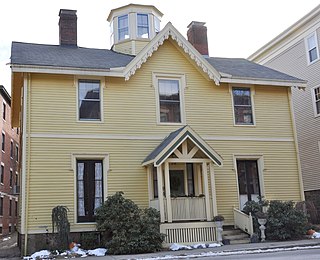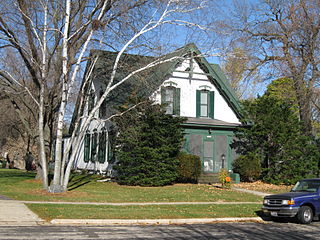
The Dr. Fisk Holbrook Day House, also known as Sunnyhill Home, is a historic house at 8000 West Milwaukee Avenue in Wauwatosa, Wisconsin. Built in 1874, it was the home of Doctor Fisk Holbrook Day (1826-1903), a prominent local physician and amateur geologist. The stylistically eclectic house was built in part to house Day's large collection of artifacts, and is the Milwaukee suburb's only major 19th-century mansion. It was declared a National Historic Landmark in 1997. It is privately owned and not open to the public.

The Thomas Aspinwall Davis House is a historic house at 29 Linden Place in Brookline, Massachusetts. The house was built in 1844, by Thomas Aspinwall Davis, later a mayor of Boston, and is one of the earliest buildings to survive from his Linden Park project, the first residential subdivision in Brookline. The house was listed on the National Register of Historic Places in 1985.

The house at 197 Morrison Avenue in Somerville, Massachusetts is the city's finest example of vernacular Gothic Revival architecture. The two story brick building was built c. 1860, and is now set well back from the street behind a later house. Its notable features include bargeboard decoration in the front gable, which also has a Gothic lancet window, and its elaborate front porch decorations. The house is unusual for its position set well back from the street, since it predates the major development that took place on Morrison Avenue in the 1870s.

The Wendell Bancroft House is a historic house in Reading, Massachusetts. Built in the late 1860s, it is one of the town's few surviving examples of residential Gothic Revival architecture, built for one of its leading businessmen of the period. The house was listed on the National Register of Historic Places in 1984.

Washington Avenue Historic District is the historic center of Cedarburg, Wisconsin, the location of the early industry and commerce that was key to the community's development. The historic district was listed on the National Register of Historic Places (NRHP) in 1986.

The Wayside House is a historic house located in Cedarburg, Wisconsin. It was built by Fredrick Hilgen, who later co-owned The Cedarburg Mill, and is considered the father of Cedarburg. It was added to the National Register of Historic Places on March 17, 1982.

The Sparrow House is an historic house at 35 Arlington Street in the Woodford's Corner neighborhood of Portland, Maine. Built in 1852, it is a well-preserved example of Gothic Revival architecture. It was listed on the National Register of Historic Places in 1982.

The David W. and Jane Curtis House is a very intact Queen Anne-styled house and matching carriage house built in 1885 in Fort Atkinson, Wisconsin, United States. It was added to the National Register of Historic Places in 2009.

The Church Street Historic District is a one-block neighborhood of historic homes built from about 1857 to 1920. It was added to the National Register of Historic Places in 1989.

The Washington Highlands Historic District is a historic subdivision in Wauwatosa, Wisconsin, planned by Hegemann & Peets starting in 1916. It was added to the National Register of Historic Places in 1989.

The David McMillan House is a High Victorian Gothic home in Stevens Point, Wisconsin, United States, which was built in 1873 by a local lumberman. It was added to the National Register of Historic Places in 1974.

The Near East Side Historic District is a neighborhood in Beloit, Wisconsin composed of stylish homes of prominent citizens from the 1800s and the buildings of Beloit College. It was added to the National Register of Historic Places in 1983.

Locust Hill is a historic home and farm complex located near Hurt, Pittsylvania County, Virginia. The house was built in two sections with the main section built in 1861, and expanded with a three-story rear ell in 1930. The original section is a 2 1/2-story, three bay, frame dwelling in the Swiss Gothic style. It has a steeply pitched gable roof that incorporates two central chimneys and four gable ends decorated in ornamental bargeboard. Also on the property are a number of contributing resources including a tavern, a servants' quarter, a kitchen, an icehouse, a chicken house, a smoke house, a dairy, a servants' quarter, a caretaker's house, a grist mill, a dam, a family cemetery, and the ruins of an 18th-century house.

The Gilmore House is a historic house at 764 River Road in Calais, Maine. The 2-1/2 story wood frame house was designed by New Brunswick architect Matthew Stead and built c. 1850, probably for Alexander Gilmore, an Irish immigrant and local merchant. The house is a remarkably sophisticated execution of Gothic Revival styling, given that at the time of its construction, Calais was essentially a frontier town. It is the most sophisticated of a trio of Gothic Revival houses. It is, like one of its neighbors, the George Washburn House, listed on the National Register of Historic Places, although its address has changed since its listing.

The George Washburn House is a historic house at 772 River Road in Calais, Maine. The 1-1/2 story wood frame house was built c. 1855 by George Washburn, and is one of a trio of Gothic Revival houses standing in a row. One of the others was built by George Washburn's brother Charles; the third, which is the most elaborate, was built by Alexander Gilmore. Nothing of substance is known of the Washburns, or of who built their houses. The George Washburn House was listed on the National Register of Historic Places in 1982, at which time its address was 318 Main Street.

The Jonas R. Shurtleff House was a historic house on United States Route 201 in Winslow, Maine. Built about 1850, it was a distinctive local example of vernacular Gothic Revival architecture. It was listed on the National Register of Historic Places in 1974.

The Gothic Cottage is a historic house at 1425 Mapleton Avenue in Suffield, Connecticut. Built in 1846, it is a distinctive local example of the Gothic cottage style popularized by Andrew Jackson Downing. It was listed on the National Register of Historic Places in 1982.

The Jens and Ingeborg Cold House is a historic home begun in Stoughton, Wisconsin in 1858 and expanded/remodeled in 1892. It was added to the State and the National Register of Historic Places in 2003.

The Iverson-Johnson House is a well-preserved historic house with unusual dragon-head decorations, built in 1898 in Stoughton, Wisconsin. It was listed on the National Register of Historic Places in 1988 and on the State Register of Historic Places the following year.

The Lincoln Street Historic District is a largely intact group of five homes built from 1880 to around 1900 in Oregon, Wisconsin. It was added to the State and the National Register of Historic Places in 2006.






















